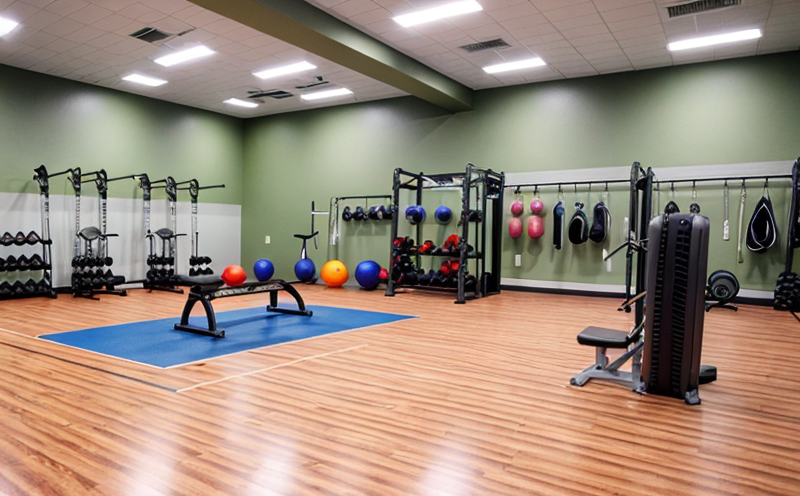Drop Testing of Sports Balls and Accessories
In the realm of consumer products and product safety testing, drop testing is a critical procedure used to evaluate the durability and performance of sports balls and accessories. This form of testing ensures that these items meet stringent standards set by regulatory bodies and industry experts. The purpose of this service is not only to provide peace of mind for manufacturers but also to ensure compliance with international standards such as ISO 20743:2018, ASTM F963-17, and EN 71-3.
Durability testing through drop impact can reveal potential weaknesses in the design or materials of sports balls and accessories. For example, a poorly designed soccer ball may not withstand repeated drops from various heights without losing its integrity. Similarly, basketballs or tennis rackets that fail to meet safety standards could pose risks during use. By subjecting these items to controlled drop tests, laboratories can identify such vulnerabilities early in the product development cycle.
The process begins with selecting appropriate specimens based on their intended use and size range. Once chosen, each item undergoes rigorous preparation procedures tailored specifically for its material composition and shape. This includes cleaning, drying, marking, and positioning them accurately within the testing apparatus. Afterward, precise measurements are taken to record initial dimensions and mass.
The actual drop test involves placing the prepared specimen into a controlled environment where it is subjected to predetermined heights and angles of impact. The chosen height range depends on factors like type of sport ball or accessory being tested; however, typical ranges might include 1 meter up to several meters depending upon the specific requirements outlined in relevant standards documents.
During the test sequence, sensors monitor key performance indicators such as deformation rate, force distribution patterns across contact surfaces, energy absorption rates, and rebound heights. These metrics help assess whether or not the product maintains its structural integrity after being dropped multiple times from different angles.
After completing all prescribed cycles of drops, technicians inspect each specimen visually for any visible signs of damage. Any defects identified during this inspection must be documented thoroughly along with detailed descriptions and photos if necessary. Following visual examination comes a thorough analysis phase where data collected throughout the testing process is reviewed against established acceptance criteria.
Based on these findings, laboratories issue comprehensive reports outlining whether or not each product passed all required tests. These documents serve as valuable tools for quality assurance teams during design reviews and manufacturing processes. They also play an important role in supporting legal compliance efforts when dealing with import/export regulations related to consumer goods.
Our laboratory uses state-of-the-art equipment designed explicitly for drop testing sports balls and accessories, ensuring accurate results every time. Our team of experienced professionals applies best practices throughout each step of the process—from specimen selection through final reporting—to deliver reliable outcomes that meet or exceed expectations set forth by industry standards.
- Our laboratory adheres strictly to ISO 20743:2018, ASTM F963-17, and EN 71-3 guidelines when conducting drop tests on sports balls and accessories.
- We employ advanced technology including high-speed cameras, force sensors, and strain gauges to gather precise data during testing.
- Our team of skilled technicians ensures consistent specimen preparation across all samples tested in order to maintain accurate comparisons between different products.
Why It Matters
Conducting drop testing on sports balls and accessories is essential for ensuring consumer safety while maintaining high-quality performance standards. When done correctly, this type of evaluation helps identify potential hazards associated with improper design choices or subpar materials early in the manufacturing process.
The results from these tests can significantly influence both product development cycles and final retail offerings by highlighting areas where improvements are needed before release into marketplaces worldwide. Compliance with international standards ensures that manufacturers adhere to strict guidelines regarding chemical content, flammability limits, and mechanical strength requirements for all parts of the sporting goods industry.
From a broader perspective, rigorous testing procedures like these contribute positively towards fostering trust between brands and consumers alike by demonstrating commitment to quality control practices. Ultimately, this builds confidence among end users who know they are purchasing safe products backed by thorough scientific validation processes.
Applied Standards
For drop testing of sports balls and accessories, several internationally recognized standards provide guidance on proper methodology and acceptable limits. Among them are:
- ISO 20743:2018 - Toy safety: This standard covers all aspects related to toy safety including mechanical properties, flammability tests, and chemical compositional analysis.
- ASTM F963-17 - Consumer safety specification for durable infant & toddler products: Although primarily focused on toys intended for very young children, many provisions within this document apply equally well to sports equipment designed for adult consumers.
- EN 71-3:2019 - Toys containing migratory elements: This European standard sets limits on certain heavy metals found in various types of toys and other recreational items sold across the EU region.
Our laboratory strictly follows these guidelines during every phase of our testing procedure, ensuring that each product meets or exceeds applicable thresholds defined by relevant authorities around the globe. By doing so, we help safeguard public health while promoting responsible business practices among industry stakeholders.
Environmental and Sustainability Contributions
- Eco-friendly packaging: We use recycled materials whenever possible when shipping products after testing, thereby reducing waste generation at the end of each project cycle.
- Energy efficiency: Our laboratory facilities are equipped with energy-saving features that minimize power consumption during routine operations. Additionally, we encourage our clients to consider sustainable manufacturing options for their own product lines whenever feasible.
- Waste reduction: Any unused samples or materials resulting from testing procedures are recycled wherever appropriate, minimizing landfill contributions and promoting circular economy principles wherever possible.
By integrating these environmental practices into our daily operations, we strive to minimize the overall ecological footprint associated with conducting drop tests on sports balls and accessories. This commitment aligns closely with broader sustainability goals shared by many leading brands operating within the consumer products sector today.





